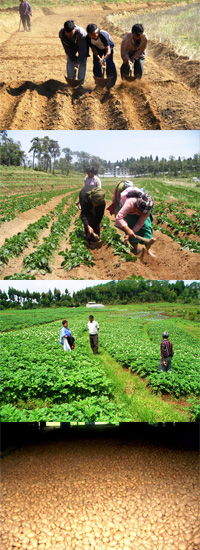 Horticulture Crops
Horticulture Crops
Potatoes
 Potato is the most important cash crop of the State.
During the period 1990-91 to 2000-01, potato occupied an average annual area of 18830.00 Ha. which constitutes about 6.79% of the total cropped area in the State.
The average annual production during this period was 157240 M.T. and the average annual yield was 8268 Kg/Ha. The computed annual growth rate in area during the same period was 210 Ha. (1.13%) with an average annual production increase of 5230 M.T. (3.33%) and an average annual growth rate of 184.87 Kg/Ha.(2.24%).
Potato is the most important cash crop of the State.
During the period 1990-91 to 2000-01, potato occupied an average annual area of 18830.00 Ha. which constitutes about 6.79% of the total cropped area in the State.
The average annual production during this period was 157240 M.T. and the average annual yield was 8268 Kg/Ha. The computed annual growth rate in area during the same period was 210 Ha. (1.13%) with an average annual production increase of 5230 M.T. (3.33%) and an average annual growth rate of 184.87 Kg/Ha.(2.24%).
Potato was first introduced in the Khasi Hills in 1930 by David Scott. The varieties initially introduced suffered from late blight disease. Subsequently, varieties such as Up-to-date, Great Scot and Arran Consul were introduced from England. These varieties were also susceptible to late blight. During the 1970s' the Central Potato Research Institute (CPRI) located at Upper Shillong tested and recommended the variety Kufri Jyoti which is superior to the earlier varieties in yield as well as resistance to late blight disease. However, the quality of Kufri Jyoti is inferior to Up-to-date variety. Of late, the resistance of Kufri Jyoti to late blight has broken down and its genetic viability has also degraded to a large extent. Recently, the CPRI has introduced Kufri Giriraj, which is a promising variety for the State.
A few other varieties like Royal Kidney, Kufri Megha and Kufri Khasi-Garo were also grown, but these have gradually been replaced to a great extent by the new 'blight resistant / tolerant varieties'.
Potato farmers of the Shillong plateau are widely acknowledged to be amongst the best farmers east of the river Ganges. They follow the prescribed package of practices religiously and accept new technology, new seeds and new plant protection measures with alacrity.





